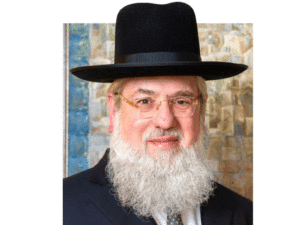This week, in Parshas Emor, we encounter the mitzvah of counting seven weeks between when the Korban Omer is brought on the second day of Pesach through the night prior to the Yom Tov we call Shavuos.
The language the posuk uses (in Devorim 16: 9) is: “Shivah shavuos tispor loch – You should count for yourself seven weeks.” Rav Chaim Vital asks why the posuk uses the term “loch,” which means for you. Chazal teach that whenever the word “loch” is used in this manner, it means that you should perform this act for your own enjoyment and benefit. A case in point would be when Hakadosh Boruch Hu told Avrohom Avinu to leave his father’s home and town: “Lech lecha… Leave where you are and go to the land I will show you…” Rashi quotes the teaching of Chazal that Hashem was telling him to go for his own enjoyment and benefit. So, why does the posuk say to count “lecha”? What personal benefit does a person derive from counting?
He answers that the period of Sefiras Ha’omer is a time of din. When we count, we remember to do teshuvah and to be mispallel that Hashem should sweeten the din.
The Shelah says it a little differently. He writes that Sefiras Ha’omer is a great mitzvah, and through the counting, a person brings upon himself a high level of kedusha. Therefore, it is incumbent upon a person who is counting to invigorate his heart through teshuvah and to make himself holy – “kadosh vetahor.”
What is so special about these days that we are now in? From where do we derive that these days have the ability to purify us and raise us to higher levels?
The Sefer Hachinuch writes that underlying the mitzvah of Sefirah is the fact that the world was created for Torah, and a primary reason that Hashem freed the Jews from Mitzrayim was so that He could give them the Torah. The ability to advance towards Har Sinai and receive the Torah was a more important factor in leaving Mitzrayim than was being freed from slavery.
Therefore, says the Chinuch, the mitzvah to count from Pesach to Shavuos was given to us to demonstrate the intense yearning to reach the appointed time. He says that this is similar to a slave who is forced to work under the blazing hot sun and counts down until the time the sun will disappear beyond the horizon and the shade will take over.
Just as a prisoner counts the days until his sentence is up and he will experience his freedom, so too, lehavdil, we count until the day we receive the Torah, for that is a portrayal of the depth of our longing for that day’s arrival.
It is well known that one reason we count for 49 days is also connected to our receipt of the Torah, because Chazal taught that there are 48 levels that a person must achieve in order to be able to properly receive and study the Torah. Each day of Sefirah, we work on attaining the next level, so that when the anticipated day of Matan Torah arrives, we will be able to accept the Torah.
Thus, we understand why these days are considered holy and special. It is because throughout the days of Sefirah, each member of Klal Yisroel is working to improve himself so that he can be a vessel worthy of Torah.
The Ramban (23:23-24) writes that the mitzvah of Sefirah and Shavuos are combined in the posuk, much like Rosh Hashanah and Yom Kippur, because just as Yom Kippur is the pinnacle of the process that began on Rosh Hashanah, so too, Shavuos is the peak of the days of Sefirah. Each day, we climb another step on the ladder that brings us to the summit of Kabbolas HaTorah.
Therefore, says the Maharal, the period of Sefirah is blessed with awesome light that is not present the rest of the year (Nesiv HaTorah 12). This spiritual light grows in intensity along with our counting, until it reaches a climax on Shavuos, when the Torah was given. He adds that when we make the count each evening, we say, “Hayom,” because “yom,” day, is an expression of light. We thank Hashem for granting us the spiritual light of this specific day of the Omer, as every day more light is revealed as we proceed along the path to Torah (Derech Mitzvosecha).
Concurrent with the light and increased levels of Torah found between Pesach and Atzeres is our obligation to raise ourselves from the level of se’orim, considered animal feed, which comprises the Korban Omer, to the more refined chitim wheat of the Shtei Halechem of Shavuos.
Chazal (Yoma 9b) teach that the second Bais Hamikdosh was destroyed because of sinas chinom; the people didn’t appreciate each other and couldn’t get along.
Perhaps we can say that until the period that followed the churban, during which the talmidim of Rabi Akiva died because of a lack of respect for each other, there was hope that the Jews would be able to repent for the sins that caused the Bais Hamikdosh to be destroyed, and just as the first Bais Hamikdosh was rebuilt after a short period of exile, so too will this one be rebuilt in a short matter of time.
When the terrible plague struck and the 24,000 talmidim of the holy Tanna perished, it became obvious to all that sins of sinas chinom were deeply embedded and the lack of ahavas Yisroel and achdus would not be easily rectified.
Perhaps they perceived that the mageifah taking place during the days of Sefirah, when there is increased ohr and daily introspection and teshuvah, indicated to them that not only were the people not worthy of having the Bais Hamikdosh, but they were also unworthy of Torah.
Had they climbed the daily steps of Sefirah and achieved the 48 kinyonim, they would have perfected their middos and would have been worthy of the return of the Bais Hamikdosh. Then, the 24,000 talmidim would not have died.
This is why the Sefirah period was declared as a time of mourning the loss of the talmidim, because as we engage in acts of bereavement, we are reminded of the punishment for not loving each other and dealing with each other respectfully. We see what happens when there is sinas chinom and a lack of respect for each other.
We are reminded that “v’ohavta lerei’acha kamocha” is not only a nice undertaking and a good minhag, but a mitzvah mide’Oraisa incumbent upon us to observe in order to be connected to Hashem and to be worthy of Torah and geulah.
During the Sefirah period, we work each day to perfect another of the 48 kinyanim of Torah and engage in raising ourselves from the nefesh habehami levels of seorim, animal food, to the nefesh haruchni at the 49th level of kedusha. These attributes prepare us for Kabbolas HaTorah, when we stood united, k’ish echod beleiv echod, at Har Sinai. They also prepare us for the unity that geulah necessitates, when Hashem echod ushemo echod will be recognized across the world.
It is important to realize that at the time of the destruction of the Bais Hamikdosh, the Jewish people excelled in the study and observance of Torah, mitzvos and chesed (see Yoma, ibid.). It’s not as if they were locked in sin and indulging in depravity. The only area in which they were lacking was ahavas Yisroel. That alone was enough to cause the destruction of the Bais Hamikdosh and bring on golus and all that it entails.
In our day, we note the explosion of Torah. There is so much that we can point to with great pride. Yeshivos and Bais Yaakovs are more plentiful and larger than ever. We have every conceivable type of chesed organization. There is unprecedented dikduk b’mitzvos. Yet, the fact that we remain in golus indicates that we are lacking in ahavas Yisroel and achdus. If sinas chinom wasn’t prevalent among us, if there wouldn’t be machlokes and division, golus would end and we would merit the geulah.
During these days of Sefirah, we should work to end the hatred, spite, cynicism and divisions amongst us. We need to take to heart the lessons of Sefirah and the passing of Rabi Akiva’s talmidim so that we can return again to where and what we were and what we are meant to be.
The Ramchal in Maamar Hachochmah discusses the idea that the Bnei Yisroel in Mitzrayim sank to the 49th level of depravity. After redeeming them from there, Hakadosh Boruch Hu provided for them the 49-day period between Pesach and Shavuos so that the freed slaves could raise themselves from the abyss of decadence and alter their behavior in a steady progression until they would be worthy of receiving the Torah on Shavuos.
The ability to raise ourselves like our forefathers did upon leaving Mitzrayim until the level that they merited receiving the Torah presents itself every year during this time, the Ramchal says. If we would dedicate ourselves to the daily tasks, we would achieve what was achieved back then.
The Ohr Hachaim adds to this idea and writes (Vayikra 23:15) that the counting of the days of the Omer is similar to the count that impure people perform to calculate the time remaining until they regain their purity. During this period, we must engage in introspection, much the same as impure people are meant to do during their period of counting.
These days involve more than a ritual counting and mourning. They demand a spiritual ascendancy to cleanse ourselves from the moral and spiritual imperfections that afflict us. During this period, we are to study and apply the 48 kinyonim of Torah to be worthy of accepting the Torah on Shavuos.
If we would utilize the strength that Hashem gave us to love and care instead of being apathetic and self-important, we could change the world.
The mourning we engage in is directly tied to the introspection that this period obligates.
On Lag Ba’omer, hundreds of thousands gather with achdus, brotherhood and love around flames dedicated to Rabi Shimon Bar Yochai. They sing songs of praise and dance with much vigor and bounce as they think of the holy Tanna and his rebbi, Rabi Akiva.
Lag Ba’omer brings a welcome interruption to the Sefirah mourning as we take haircuts, shave, trim our beards, and allow music to cheer our souls once again.
Rabi Akiva was the greatest of his generation. It is said that he was the root of Torah Shebaal Peh. The line of transmission of the Torah from Har Sinai to future generations ran through him and his students. When his original students died, the Jewish world mourned. They worried about how the mesorah that ran through Rabi Akiva would be able to continue. Fresh from mourning the destruction of the Bais Hamikdosh, they now mourned the loss of so many Torah giants. Every day, there were hundreds of funerals for the people whom everyone had counted on to be the future leaders and teachers of Klal Yisroel. A grieving people on the run from Roman persecution, they feared for the future.
As was his way, Rabi Akiva recharged the people and helped them recover from the devastating losses. He set out to transmit the Torah to a group of five new students, through whom the chain leading back to Sinai and forward to us was established.
On Lag Ba’omer, we not only celebrate the day when the plague ended and commemorate the renewal that Rabi Akiva led through Rabi Shimon and four others. We celebrate that on this day as well, Rabi Shimon Bar Yochai revealed the secrets of Toras Hasod, which infused the future generations with added dimensions of kedusha and understanding of Torah and Hashem’s creation.
As the centuries pass, and as the Romans of every period seek our destruction and annihilation, we look to Rabi Akiva and Rabi Shimon Bar Yochai for inspiration. We note how they persevered in the face of tragedy and destruction, ensuring that our nation and Torah live and flourish until today.
As we celebrate their determination, we are able to foresee a bright future.
As the golus continues, we must not weaken in our devotion to Torah. Noting how many giants our people have lost, we hear voices stating that we can never recover from the losses. We are doomed to mediocrity, they proclaim.
Lag Ba’omer rejects that hopelessness. It declares that we are never to give up hope or allow the chain of greatness to break. The fires of Lag Ba’omer burn vibrantly, announcing that the future will be bright, the mesorah will continue, and our people will be great.
In our day, once again, we experience the Jewish eternal struggle. Those who were considered friends and allies turn on us. They spread blood libels about us, accusing us of the wanton murder of women and children. They incite massive hatred of Jews in this country and around the world. They protect an evil terror group and its leaders, even after they perpetrated genocide against the Jewish people.
As the Jewish state has their leaders and remnants of their army surrounded, the leader of the world’s most powerful democracy not only withholds necessary weapons from the Jews to prevent them from concluding the war and eliminating the terror group that threatens Israel and the Western world, but the great bulwark of liberty keeps to itself information that would lead Israel to the terror chief and the over 100 hostages kidnapped from Israel.
The president spent half a century portraying himself as a Zionist to earn the support of Jews. In fact, however, he worked to undermine Israel, trying to bring down Israel’s current democratically elected leader and conducting hand-to-hand combat with previous leaders, such as Menachem Begin, as he threatened the lone democracy in the Middle East and one of America’s greatest allies.
People in Eretz Yisroel and chutz la’aretz worry about the anti-Semitism that has been unleashed. They fear to walk the streets in their cities and wonder where this will all lead if permitted to continue to fester, grow and take root. They wonder what can be done to stem the threatening tide that is washing over the world.
The Sefirah period is meant to bring out the best in us, allowing us to rise and benefit from the light and holiness of these days. May we merit to use these days to become worthy of Torah and geulah, so that we will have greatness, peace and Moshiach very soon.







